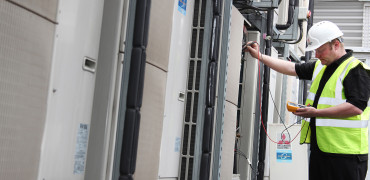At the time of writing, it’s cold here in the UK, with many parts of the country even facing snow. There have also been several predictions that we are likely to face a harsh winter this year which is bad news for energy bills and puts pressure on both household and business budgets.
I’m rather interested in this for two very personal reasons. Firstly, my gas heating at home is not working properly so we’re not as warm and cosy as we would like to be; and secondly, a cold winter is going to mean bigger gas and electricity bills come the spring.
I’ve got a heating engineer coming out soon so that will hopefully sort out the first issue and with regards to the second, I know I’ve been slightly overpaying my utility bills during the summer so have some of this ‘banked’ with my suppliers which should help offset the extra use during these colder months.
At least it’s warm at work
I’m lucky enough to work in an air conditioned office with a system that is able to take excess heat from one area, such as the kitchens or server rooms, to use in other areas, such as offices and meeting rooms. This helps keep the running costs down somewhat.
However, it doesn’t mean it’s warm and cosy all the time though as different people have different requirements and you can find yourself enter a meeting room that has previously been occupied by someone who is obviously descended from an Eskimo.
We also have a good balance of male and female in the open plan office I work in, and without wishing to be too stereotypical or generalise too much, heat does seem to divide the sexes somewhat in most of the places I’ve ever worked.
- Are men ‘tougher’ than women when it comes to warmth?
- Are they just less sensitive about these things in general?
- Or are they just trying to be ‘macho’ and are actually just as cold as their female colleagues?
Actually, according to an article publish in 2015 in nature.com and reported in last week’s Independent the ‘set’ temperatures for most office buildings are sexist because they are based on a “decades-old formula that uses the metabolic rates of men.”
Sock it to them
I can see that the metabolism of a person will affect their comfort levels and there may well be something to this but for me, one of the things that might make a difference is the simple fact that men always wear socks to work and a lot of women don’t.
And that brings me to the core of what I’m trying to focus on here: How can you keep warm whilst making sure you’re not just wasting energy.
At work, it’s easy to think it’s the bosses’ job to make sure you are warm and many people are quick to complain if they are too hot or too cold.
This report on the BBC3 website today looks at temperatures at work and asks: “just how cold can it get before you can legally go home?”.
As the report states, there are no legal upper or lower limits for offices but the HSE (Health & Safety Executive) says employers are legally obliged to keep the indoor temperature ‘comfortable’. The guidelines suggest a minimum temperature of 16 degrees Celsius, which is about 61 degrees Fahrenheit.
And whilst it is indeed a responsibility of every employer to provide a safe and comfortable workplace, there are things you could be doing yourself to make your time in the office more comfortable?
Make your time in the office more comfortable
Ask yourself these simple questions
-
Have you had a proper breakfast?
Leaving home with something warm inside you will help fuel you on the journey to work, make you feel better and therefore more positive
-
Are you dressed properly for winter on your journey to work?
If you head off to work without a proper coat, jacket, gloves, hat, scarf, etc. then you are likely to arrive pretty frozen, which means you’ll need to spend the first part of the day warming yourself up
-
Are you dressed properly whilst you are at work?
If you’ve come to work in something more appropriate for the summer, then it’s little wonder you’re feeling cold all day
-
If your job involves a lot of sitting, do you take regular breaks?
Inactivity can exacerbate feeling cold and moving is one way of combating this. In addition, taking a break is not only good for your posture but can also act as a way of taking time to stop and think about the task in hand. Go make a coffee. Ask your colleagues if they want one. Take 5 minutes to ask how people are.
-
Are you exercising enough?
I for one know that I do not get enough exercise, so I always take the stairs instead of the lift – and take them two at a time, so it takes more effort. Regardless of whether you go to the gym, are into jogging, or sport, there are things you can do such as take a walk during your lunchbreak – wearing appropriate winter clothes of course!
Part of any person’s job should be to help their business or organisation to prosper, thereby helping ensure their own job security. Making sure you keep yourself warm at work without wasting costly energy is one small way of keeping yourself focused and ready for the task ahead, and keeping your organisation profitable / viable.
Of course there should be no place for unscrupulous bosses who simply won’t provide safe and comfortable workspaces but there are small things you can do to make yourself comfortable in one of the places you spend so much of your time in.
Dressing appropriately for the seasons could help you keep your workplace comfortable without having to ramp up the thermostat to max.
Not only will this be good for the bottom line because it minimises the energy costs, it’s also good for the environment – and this is something that collectively, we all know we need to do something about.
Buildings are by far the biggest consumers of energy, so if we can find ways to keep comfortable whilst minimising the amount of energy the building uses, we can really start to make a difference.
And the same applies at home
When the cold snap starts, it’s easy to want to curl up under the duvet and stay in bed but we’re simply not built for hibernation throughout winter as this article by my colleague Ellina Webb explains.
So, rather than carrying on as you always do and walking around your home in a t-shirt when the cold weather comes, do you think of putting a jumper or cardigan on before switching on the heating?
At the moment, I’ve taken to wearing my coat indoors (because of my inadequate gas heating of course), but it has also got me questioning how much we heat the home when we don’t need to – and how much energy I’m wasting and of course, the cost.
We’ve also broken out the blankets which are ideal for keeping legs and feet warm whilst watching TV and can also mean you can turn the thermostat down a little.
If you are going out, do you just leave the heating on so that it’s warm when you get back? Of course you do. We all do.
But how long are you going out for? If it’s more than 2 to 3 hours, it’s probably worth turning off the heating and scheduling it to come on about an hour before you arrive home again. Why pay to heat an empty home?
I’ve also seen money saving ‘advice’ on the internet suggesting you turn off the heating in empty rooms to save money.
Whilst there is sense in this approach, it’s worth remembering the British weather and that unheated rooms are prone to damp as this could lead to the development of mould.
So it’s probably better to keep the heating on in empty rooms but turn the room thermostat down to a temperature that saves energy but keeps the room warmer than the outdoors.
Keep the doors shut
One easy way to lower you heating bills is to keep the doors between rooms shut. Not only does this help regulate the temperature in the room you are in better, keeping you comfortable whilst in that room, it also cuts down on the number of draughts.
And whilst we’re on the subject of draughts, just how leaky is your home? Have you looked at sealing up any gaps under doors and around windows that you don’t normally notice?
I’ve also heard good things about the idea of putting tin foil behind the radiators to reflect and increase the heat coming into the room.
Train your family
It is easy to characterise children in particular as wasteful as a previous British Gas advert did, showing the ‘dad’ as the only person going round the house turning off unused lights and lowering the thermostat.
Today though, I think we’re more likely to receive a lecture from the younger members of the family! It is after all, their planet that is facing such a tough future.
Here at Mitsubishi Electric though, we’ve now had thousands of primary-age children through our environmental educational programme – The Learning Curve, and it is amazing how quickly children get it.
Suitably inspired, these new ‘eco warriors’ are then empowered to go back to their schools and homes and try to make a real difference.
This other Hub article looks at how my colleague has tried to prepare her new home for its first winter and there are several others looking at this aspect, such as this one demonstrating how you can ‘Hygge’ your home.
So there’s quite a lot you can do to keep yourself comfortable whilst keeping the energy bills down.
Now when is that gas man due to arrive?
Russell Jones is Content and Communications Manager for Mitsubishi Electric, Living Environment Systems in the UK.


